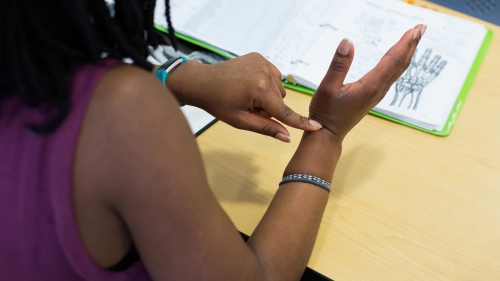

Anita Perr uses collaborative teaching to encourage students to explore the best ways to approach clinically relevant issues. Her extensive clinical experience informs her classroom teaching. Students appreciate the problem-based, practical nature of her courses.
Anita Perr has expertise in the use of assistive technology by persons with disabilities and has lectured on topics such as seating and positioning and adaptive computer technology. She has presented at local and national conferences on topics such as environmental accessibility, wheelchair mobility, and assistive technology. Anita has written and co-authored many papers and textbook chapters.
Ms. Perr holds a certification in Neurodevelopmental Treatment of the Adult Hemiplegic and was certified as an Assistive Technology Professional for many years. As a member of the Rehabilitation Engineering and Assistive Technology Society of North America (RESNA), she has been involved in the credentialing process for Assistive Technology Practitioners, Assistive Technology Suppliers, and Rehabilitations Engineers. Collaborations with NYU Tisch's ITP and NYU Tandon's IDM Program have resulted in the development of the NYU Ability Project, an interdisciplinary research space for the development of assistive technologies.
Anita retired in 2024 and continues to teach as an adjunct.
Selected Publications
- Koch, K.E, Kopplin, K., & Perr, A. (2025). What are Wheelchair and Wheelchair Seating Standards? In Minkel and M.L. Lange (Eds.), Seating and Wheeled Mobility: A clinical resource guide, 2nd edition. Thorofare, NJ.Perr, A. (2020). Restoring transfers and functional mobility. In D. Dirette and S. Gutman (Eds.), Occupational Therapy in Physical Dysfunction. NY, NY: Wolters Kluwer.
- Koch, KE & Perr, A. (2018). Application of Wheelchair and Seating Standards: From Inside the Test Lab and Beyond. In ML Lange and JL Minkel (Eds.), Seating and Wheeled Mobility: A Clinical Resource Guide. Thorofare, NJ: Slack.
- Perr, A. & Howe, T-S. (2014). Self care occupations. In J. Hinojosa, & M. L. Blount (Eds.), The texture of life: Purposeful activities in the context of occupation (4th ed,). Bethesda, MD: AOTA Press.
- Perr, A. (2014). Independence: Simulation of life activities to occupation. In J. Hinojosa, & M. L. Blount (Eds.), The texture of life: Purposeful activities in the context of occupation (4th ed,). Bethesda, MD: AOTA Press.
- Axelson, P., Minkel, J., & Perr, A. (2013). The manual wheelchair training guide, 2nd edition. Minden, NV: PAX Press.
- Perr, A. & Bell, P. (2009). Moving from simulation to real-life activity and human occupation. In J. Hinojosa, & M. L. Blount (Eds.), The texture of life: Purposeful activities in the context of occupation (3rd ed., pp. 335-365). Bethesda, MD: AOTA Press.
- Perr, A. (2009). Range of human activity: Self-care occupations. In J. Hinojosa & M. L. Blount (Eds.), The texture of life: Purposeful activities in the context of occupation (3rd ed., 435-451). Betheseda, MD: AOTA Press.
- Perr, A. & Miller, J. (2009). Range of human activity: Work occupations. In J. Hinojosa & M. L. Blount (Eds.), The texture of life: Purposeful activities in the context of occupation (3rd ed., pp 409- 433). Bethesda, MD: AOTA Press.
